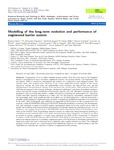Mostrar o rexistro simple do ítem
Modelling of the long-term evolution and performance of engineered barrier system
| dc.contributor.author | Claret, Francis | |
| dc.contributor.author | Dauzeres, Alexandre | |
| dc.contributor.author | Jacques, Diederik | |
| dc.contributor.author | Sellin, Patrik | |
| dc.contributor.author | Cochepin, Benoit | |
| dc.contributor.author | De Windt, Laurent | |
| dc.contributor.author | Garibay-Rodríguez, Jaime | |
| dc.contributor.author | Govaerts, Joan | |
| dc.contributor.author | Leupin, Olivier | |
| dc.contributor.author | Mon, Alba | |
| dc.contributor.author | Montenegro, Luis | |
| dc.contributor.author | Montoya, Vanessa | |
| dc.contributor.author | Prasianakis, Nikolaos | |
| dc.contributor.author | Samper, Javier | |
| dc.contributor.author | Talandier, Jean | |
| dc.date.accessioned | 2023-03-17T17:26:28Z | |
| dc.date.available | 2023-03-17T17:26:28Z | |
| dc.date.issued | 2022 | |
| dc.identifier.citation | Francis Claret, Alexandre Dauzeres, Diederik Jacques, Patrik Sellin, Benoit Cochepin, Laurent De Windt, Jaime Garibay-Rodriguez, Joan Govaerts, Olivier Leupin, Alba Mon Lopez, Luis Montenegro, Vanessa Montoya, Nikolaos I. Prasianakis, Javier Samper and Jean Talandier. Modelling of the long-term evolution and performance of engineered barrier system, EPJ Nuclear Sci. Technol. 8, 41 (2022) | es_ES |
| dc.identifier.uri | http://hdl.handle.net/2183/32716 | |
| dc.description | Euratom Research and Training in 2022: challenges, achievements and future perspectives | es_ES |
| dc.description.abstract | [Abstract:] Components of the so-called “multiple-barrier system” from the waste form to the biosphere include a combination of waste containers, engineered barriers, and natural barriers. The Engineered Barrier System (EBS) is crucial for containment and isolation in a radioactive waste disposal system. The number, types, and assigned safety functions of the various engineered barriers depend on the chosen repository concept, the waste form, the radionuclides waste inventory, the selected host rock, and the hydrogeological and geochemical settings of the repository site, among others. EBS properties will evolve with time in response to the thermal, hydraulic, mechanical, radiological, and chemical gradients and interactions between the various constituents of the barriers and the host rock. Therefore, assessing how these properties evolve over long time frames is highly relevant for evaluating the performance of a repository system and safety function evaluations in a safety case. For this purpose, mechanistic numerical models are increasingly used. Such models provide an excellent way for integrating into a coherent framework a scientific understanding of coupled processes and their consequences on different properties of the materials in the EBS. Their development and validation are supported by R&D actions at the European level. For example, within the HORIZON 2020 project BEACON (Bentonite mechanical evolution), the development, test, and validation of numerical models against experimental results have been carried out in order to predict the evolution of the hydromechanical properties of bentonite during the saturation process. Also, in relation to the coupling with mechanics, WP16 MAGIC (chemo Mechanical AGIng of Cementitious materials) of the EURAD Joint Programming Initiative focuses on multi-scale chemo-mechanical modeling of cementitious-based materials that evolve under chemical perturbation. Integration of chemical evolution in models of varying complexity is a major issue tackled in the WP2 ACED (Assessment of Chemical Evolution of ILW and HLW Disposal cells) of EURAD. WP4 DONUT (Development and improvement of numerical methods and tools for modeling coupled processes) of EURAD aims at developing and improving numerical models and tools to integrate more complexity and coupling between processes. The combined progress of those projects at a pan-European level definitively improves the understanding of and the capabilities for assessing the long-term evolution of engineered barrier systems. | es_ES |
| dc.description.sponsorship | Euratom research and training program 2014–2018; 745942 | es_ES |
| dc.description.sponsorship | Ministerio de Ciencia e Innovación; PID2019-109544RB-I00 | es_ES |
| dc.language.iso | eng | es_ES |
| dc.publisher | EDP Sciences | es_ES |
| dc.relation | info:eu-repo/grantAgreement/EC/H2020/847593 | es_ES |
| dc.relation.uri | https://doi.org/10.1051/epjn/2022038 | es_ES |
| dc.rights | Atribución 3.0 España | es_ES |
| dc.rights.uri | http://creativecommons.org/licenses/by/3.0/es/ | * |
| dc.subject | Engineered Barrier System (EBS) | es_ES |
| dc.subject | Radioactive waste | es_ES |
| dc.subject | Mechanistic numerical models | es_ES |
| dc.subject | Project BEACON | es_ES |
| dc.subject | Bentonite mechanical evolution | es_ES |
| dc.subject | EURAD Joint Programming Initiative | es_ES |
| dc.subject | WP2 ACED | es_ES |
| dc.subject | Assessment of Chemical Evolution of ILW and HLW Disposal cells | es_ES |
| dc.subject | WP16 MAGIC | es_ES |
| dc.subject | Mechanical AGIng of Cementitious materials | es_ES |
| dc.subject | WP4 DONUT | es_ES |
| dc.subject | Development and improvement of numerical methods and tools for modeling coupled processes | es_ES |
| dc.title | Modelling of the long-term evolution and performance of engineered barrier system | es_ES |
| dc.type | info:eu-repo/semantics/article | es_ES |
| dc.rights.access | info:eu-repo/semantics/openAccess | es_ES |
| UDC.journalTitle | EPJ Nuclear Sciences & Technologies | es_ES |
| UDC.volume | 8 | es_ES |
| UDC.startPage | 41 | es_ES |
| dc.identifier.doi | 10.1051/epjn/2022038 |






